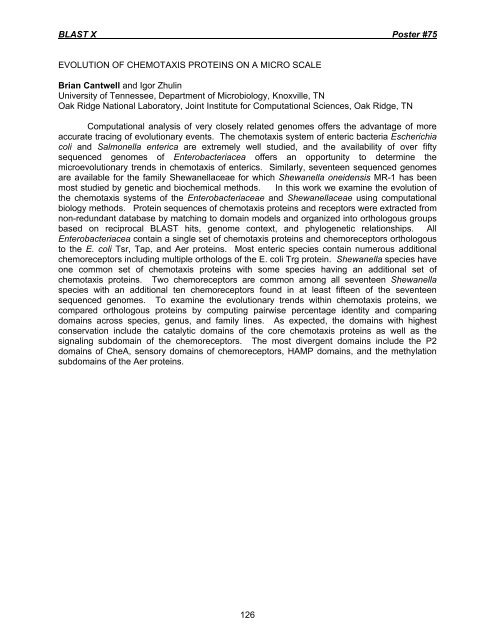POSTERS - BLAST X - University of Utah
POSTERS - BLAST X - University of Utah
POSTERS - BLAST X - University of Utah
You also want an ePaper? Increase the reach of your titles
YUMPU automatically turns print PDFs into web optimized ePapers that Google loves.
<strong>BLAST</strong> X Poster #75<br />
EVOLUTION OF CHEMOTAXIS PROTEINS ON A MICRO SCALE<br />
Brian Cantwell and Igor Zhulin<br />
<strong>University</strong> <strong>of</strong> Tennessee, Department <strong>of</strong> Microbiology, Knoxville, TN<br />
Oak Ridge National Laboratory, Joint Institute for Computational Sciences, Oak Ridge, TN<br />
Computational analysis <strong>of</strong> very closely related genomes <strong>of</strong>fers the advantage <strong>of</strong> more<br />
accurate tracing <strong>of</strong> evolutionary events. The chemotaxis system <strong>of</strong> enteric bacteria Escherichia<br />
coli and Salmonella enterica are extremely well studied, and the availability <strong>of</strong> over fifty<br />
sequenced genomes <strong>of</strong> Enterobacteriacea <strong>of</strong>fers an opportunity to determine the<br />
microevolutionary trends in chemotaxis <strong>of</strong> enterics. Similarly, seventeen sequenced genomes<br />
are available for the family Shewanellaceae for which Shewanella oneidensis MR-1 has been<br />
most studied by genetic and biochemical methods. In this work we examine the evolution <strong>of</strong><br />
the chemotaxis systems <strong>of</strong> the Enterobacteriaceae and Shewanellaceae using computational<br />
biology methods. Protein sequences <strong>of</strong> chemotaxis proteins and receptors were extracted from<br />
non-redundant database by matching to domain models and organized into orthologous groups<br />
based on reciprocal <strong>BLAST</strong> hits, genome context, and phylogenetic relationships. All<br />
Enterobacteriacea contain a single set <strong>of</strong> chemotaxis proteins and chemoreceptors orthologous<br />
to the E. coli Tsr, Tap, and Aer proteins. Most enteric species contain numerous additional<br />
chemoreceptors including multiple orthologs <strong>of</strong> the E. coli Trg protein. Shewanella species have<br />
one common set <strong>of</strong> chemotaxis proteins with some species having an additional set <strong>of</strong><br />
chemotaxis proteins. Two chemoreceptors are common among all seventeen Shewanella<br />
species with an additional ten chemoreceptors found in at least fifteen <strong>of</strong> the seventeen<br />
sequenced genomes. To examine the evolutionary trends within chemotaxis proteins, we<br />
compared orthologous proteins by computing pairwise percentage identity and comparing<br />
domains across species, genus, and family lines. As expected, the domains with highest<br />
conservation include the catalytic domains <strong>of</strong> the core chemotaxis proteins as well as the<br />
signaling subdomain <strong>of</strong> the chemoreceptors. The most divergent domains include the P2<br />
domains <strong>of</strong> CheA, sensory domains <strong>of</strong> chemoreceptors, HAMP domains, and the methylation<br />
subdomains <strong>of</strong> the Aer proteins.<br />
126


